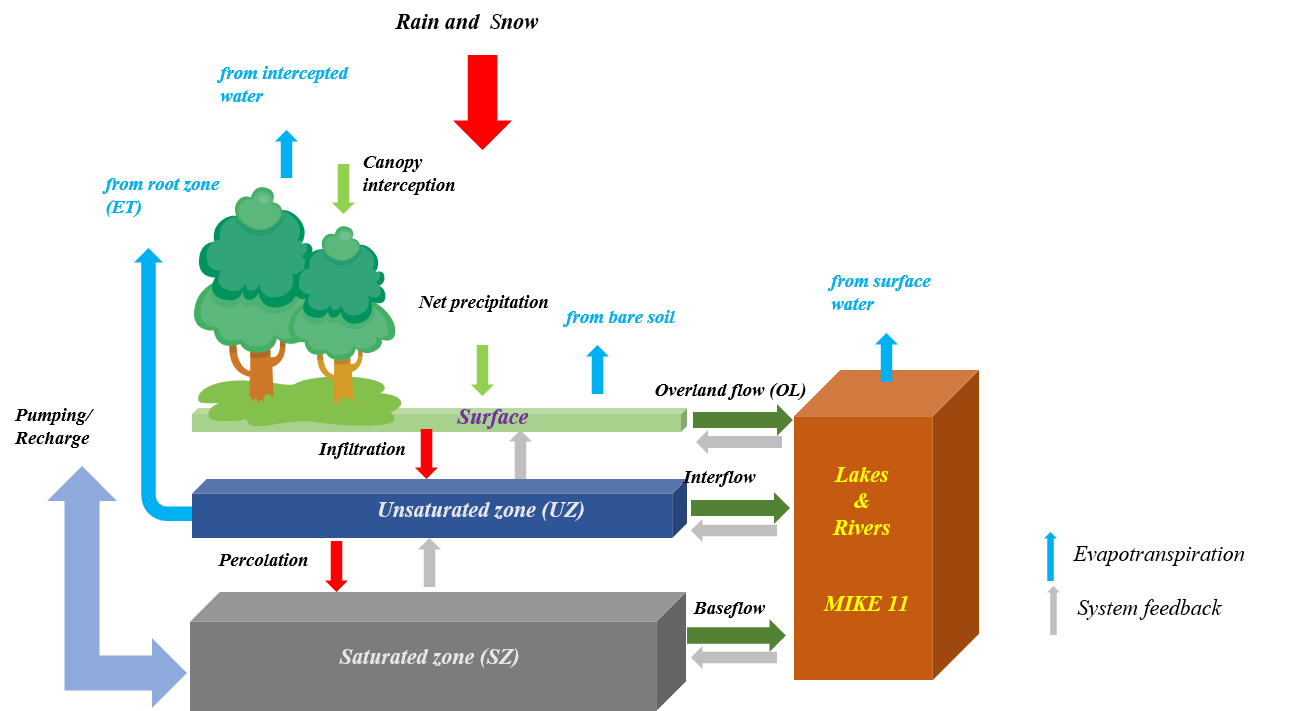The hydrologic models:
The impacts of watershed management practices and future climate were quantified using coupled MIKE-SHE and MIKE-11 models. MIKE-SHE is a physically-based, distributed model that simulates the hydrologic system (Figure 1). Once the water reaches the river, a 1D hydrodynamic model, MIKE-11, simulates the propagation of the hydrograph along the river using a 1D dynamic wave equation. The transport and fate of contaminants in the river are simulated using a generic advection-dispersion equation.

Figure 1. The MIKE-SHE model computes the processes and storages in a hydrologic system using the following relationships: Evapotranspiration: Kristen & Jensen Overland flow: 2D; Diffusive wave; Unsaturated zone flow: 1D Richards Equation; Saturated zone flow: 3D Darcy Equation; Contaminant transport: Advection-Dispersion-Equation.
Inputs to MIKE-SHE and MIKE-11 consisted of physically measured climate, watershed, and river attributes (Figure 2). The outputs are time series of maps of the processes and storages, for example, daily maps of actual evapotranspiration.

Figure 2. Input data for MIKE-SHE and MIKE-11
The Watershed Management Practices (WMPs)
Watershed management practices (WMPs), such as crop rotation, riparian buffers, and
wetland construction among others, are typically implemented to address water problems such as flooding, excessive sediment load, and water quality impairment in an intensively managed watershed. The quantification of watershed responses to these practices is achieved through assessment endpoints such as streamflow or species concentration at the outlet. WPMs may be hypothetical or real changes in the landscape that were conceptualized in MIKE-SHE to determine how the watershed responds to these alterations. For instance, how will constructed wetlands impact the streamflow and groundwater in the watershed? More detailed information about this study can be found in:
Botero-Acosta, A., M L. Chu, A. Stumpf. 2018. Impacts of environmental stressors on the water resources of intensively managed hydrologic systems. Hydrol Process. 2018; 32:2947–2962. doi.org/10.1002/hyp.13244
Water Quality in the USRB
The changes to the water quality of the USRB were assessed through the changes in sediment and Nitrogen load at the three gauging stations: Fisher, Monticello, and Decatur. A MIKE-SHE/MIKE-11 model was developed for the USRB to simulate the nonpoint source pollution transport and fate across the watershed and into the Upper Sangamon river system. The following methodology was implemented:
- Develop transport model for sediments and nitrogen
- Apply the Modified Universal Soil Loss Equation (MUSLE) to quantify the monthly overland sediment yield.
- Inputs of fertilizer – application schedule for corn in Illinois to simulate the nonpoint source of Nitrogen.
- Simulate the hydrologic and transport processes in the USRB under selected WMP-climate scenarios using a generic advection-dispersion-equation.

Figure 3. The generic Advection-Dispersion-Equation used to simulate the fate and transport of Nitrogen and sediment in the USRB.

